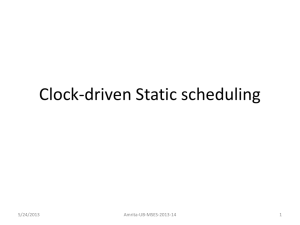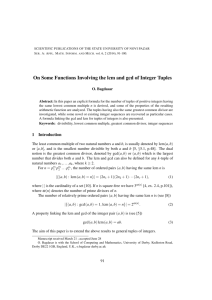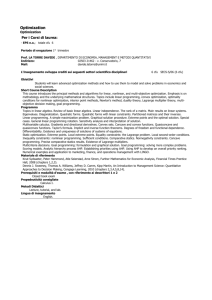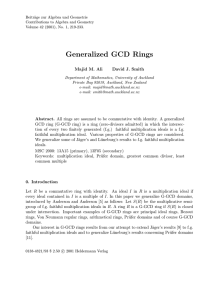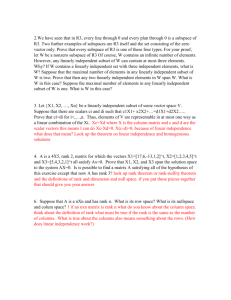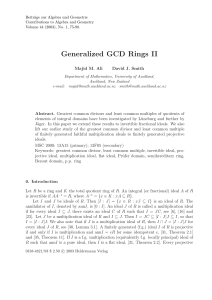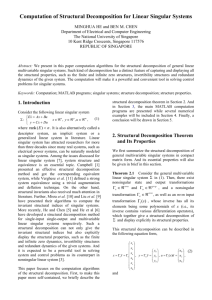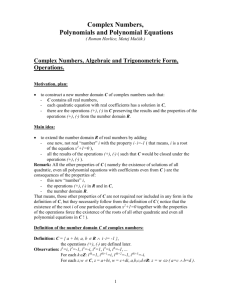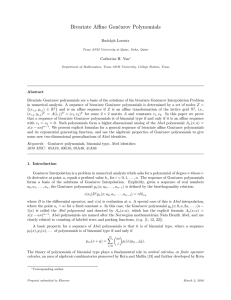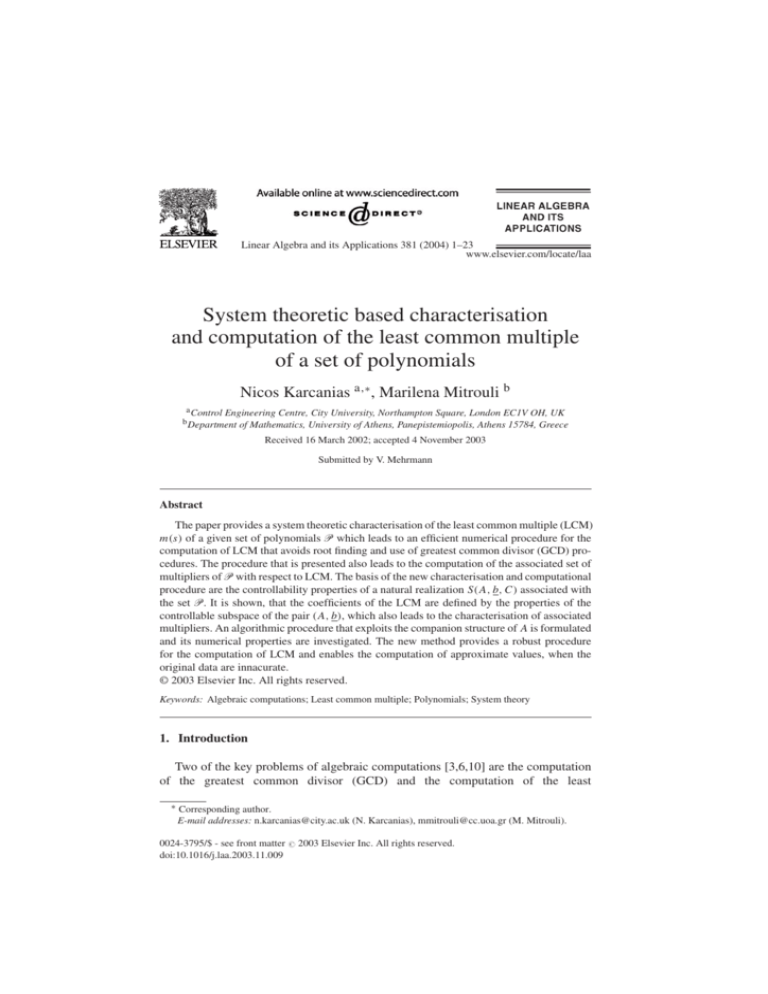
Linear Algebra and its Applications 381 (2004) 1–23
www.elsevier.com/locate/laa
System theoretic based characterisation
and computation of the least common multiple
of a set of polynomials
Nicos Karcanias a,∗ , Marilena Mitrouli b
a Control Engineering Centre, City University, Northampton Square, London EC1V OH, UK
b Department of Mathematics, University of Athens, Panepistemiopolis, Athens 15784, Greece
Received 16 March 2002; accepted 4 November 2003
Submitted by V. Mehrmann
Abstract
The paper provides a system theoretic characterisation of the least common multiple (LCM)
m(s) of a given set of polynomials P which leads to an efficient numerical procedure for the
computation of LCM that avoids root finding and use of greatest common divisor (GCD) procedures. The procedure that is presented also leads to the computation of the associated set of
multipliers of P with respect to LCM. The basis of the new characterisation and computational
procedure are the controllability properties of a natural realization S(A, b, C) associated with
the set P. It is shown, that the coefficients of the LCM are defined by the properties of the
controllable subspace of the pair (A, b), which also leads to the characterisation of associated
multipliers. An algorithmic procedure that exploits the companion structure of A is formulated
and its numerical properties are investigated. The new method provides a robust procedure
for the computation of LCM and enables the computation of approximate values, when the
original data are innacurate.
© 2003 Elsevier Inc. All rights reserved.
Keywords: Algebraic computations; Least common multiple; Polynomials; System theory
1. Introduction
Two of the key problems of algebraic computations [3,6,10] are the computation
of the greatest common divisor (GCD) and the computation of the least
∗ Corresponding author.
E-mail addresses: n.karcanias@city.ac.uk (N. Karcanias), mmitrouli@cc.uoa.gr (M. Mitrouli).
0024-3795/$ - see front matter 2003 Elsevier Inc. All rights reserved.
doi:10.1016/j.laa.2003.11.009
2
N. Karcanias, M. Mitrouli / Linear Algebra and its Applications 381 (2004) 1–23
common multiple (LCM) of a set of polynomials. From the applications in Control
Theory viewpoint the GCD is linked with the computation of zeros of representations
whereas LCM is connected with the derivation of minimal fractional representations
of rational models, which are essential for the study of a variety of algebraic design
problems [10].
We may always consider a set of polynomials in a degree ordered representation
i.e. P = {pi (s), i ∈ k : pi (s) ∈ R[s], ∂{pi (s)} = di , d1 = n d2 = m di , i =
∼
3, . . . , k}. Such sets, with fixed the first two maximal degrees (n, m) may be represented by their coefficient vectors pi , where p1 ∈ Rn+1 , pi ∈ Rm+1 , i = 2, 3, . . . , k
and the set P by the vector p = [pt1 , p t2 , . . . , ptk ]t ∈ Rσ , σ = (n + 1) + (m + 1)(k −
1), or by a point P in the projective space Pσ −1 (R). Such a representation is linked
to the generalised resultant [1] and allows the discussion of properties of sets P,
when there is uncertainty in their coefficients.
The GCD and LCM problems are naturally interlinked [9], but they are of a different nature. For k-sets of polynomials ordered by the two maximal degrees (n, m),
those who have a nontrivial GCD (different than 1), belong to a proper variety of
Pσ −1 (R). Such variety is defined by the set of minors of the generalised resultant
associated with P. In this sense, the existence of a nontrivial GCD is a nongeneric
property. However, for every P set the corresponding LCM always exist. It is such
properties which make the GCD and LCM computational processes different. In
fact, the difference in nature of GCD and LCM computations is expressed by the
fact that uncertainty in the coefficients of the set of polynomials results in coprimeness and thus we have a trivial GCD equal to 1. This is due to that the existence
of nontrivial GCD is a nongeneric property [5,13,17]. However, the same problem
for LCM results always in a nontrivial solution with error in the coefficients and the
degree.
For the case of two polynomials t1 (s), t2 (s) with LCM p(s) and GCD z(s), we
have the standard identity that t1 (s)t2 (s) = z(s)p(s), which indicates the natural
linking of the two problems. For randomly selected polynomials, the existence of
a nontrivial GCD is a “nongeneric” property [9,17], but the corresponding LCM
always exists. This suggests that there are fundamental differences between the two
computational problems; such problems acquire a special dimension for engineering models, where uncertainty about the true value of the parameters on one hand
and (rounding off) computational errors on the other, makes the computation of
nongeneric values of invariants a very difficult task. This creates the need for the
development of procedures, which lead to meaningful “approximate” solutions. Such
computations are referred to as “approximate”, or robust algebraic computations
[9]. The case of GCD computation has taken a lot of attention [8,9,12] (and references there in) and algorithms dealing with the evaluation of exact and approximate
solutions have been derived.
This paper deals with the corresponding problems of LCM computation, which
has taken much less attention so far. Existing procedures for the computation of LCM
N. Karcanias, M. Mitrouli / Linear Algebra and its Applications 381 (2004) 1–23
3
rely on the standard factorisation of polynomials, computation of a minimal basis
of a special polynomial matrix [2] and use of algebraic identities, GCD algorithms
and numerical factorisation of polynomials [7]. This paper presents an alternative
approach to the computation of LCM, which is based on standard system theory
concepts and avoids root finding, as well as use of the algebraic procedure and GCD
computation. The new characterisation of LCM leads to an efficient computational
procedure based on properties of controllability of a linear system, associated with
the given set of polynomials, and also provides a procedure for the computation of
the associated set of polynomial multipliers linked to LCM.
For a given set of polynomials P a natural realization S(A, b, C) is defined by
inspection of the elements of the set P. It is shown that the degree r of LCM is
equal to the dimension of the controllable subspace of the pair (A, b), whereas the
coefficients of LCM express the relation of Ar b with respect to the basis of the
controllable space. The companion form structure of A simplifies the computation of
controllability properties and leads to a simple procedure for defining the associated
set of polynomial multipliers of P with respect to LCM. A special feature of the
algorithmic procedure is that a number of possibly difficult steps are substituted by
simple closed formulae derived from the special structure of the system. An overall
algorithmic procedure is formulated for computing LCM and multipliers, which is
based on standard numerical linear algebra procedures. The numerical aspects of the
algorithm are investigated and demonstrated by a number of examples. The developed results provide a robust procedure for the computation of LCM and enable the
computation of approximate values, when the original data have some numerical
inaccuracies. In such cases the method computes an approximate LCM with degree
smaller than the “generic” degree (see Example 4.3 of Section 4 of the paper). In
fact, a generic set of polynomials is coprime and thus their LCM is their product. The
existence of an LCM with degree different than that of the product of polynomials
occurs only when the given set of polynomials is not coprime. In fact, an LCM
with degree less than the degree of the product of all polynomials implies that at
least two polynomials in the set have a nontrivial GCD and this is a “nongeneric”
property. Therefore, this degree with value less than the degree of the product is a
“nongeneric” property for the set of all k-number polynomials (ordered by the (n, m)
degrees.
Throughout the paper if a property is said to be true for i ∈ k , k ∈ Z+ , this means
∼
it is true for all 1 i k. The proof of the results are given in Appendix A.
2. Problem statement, definitions and preliminary results
Consider the set of polynomials P = {pi (s), i ∈ k : pi (s) ∈ R[s], ∂{pi (s)} = di },
∼
where R[s] denotes the ring of polynomials over R and ∂{·} denotes the degree function. By LCM {P} p(s) and GCD {P} z(s) we shall denote the LCM and GCD
4
N. Karcanias, M. Mitrouli / Linear Algebra and its Applications 381 (2004) 1–23
of the set P respectively. Without loss of generality, we may assume the polynomials
pi (s) to be monic, i.e.
pi (s) = s di + a1i s di −1 + · · · + adi i −1 s + adi i ,
i ∈ k,
∼
(2.1)
where aji denotes the coefficient aj of the ith polynomial of the set. We define the
rational vector associated with P
p1 (s)−1
p2 (s)−1
g P (s) = . ∈ Rk (s)
(2.2)
..
pk (s)−1
as the associated rational representative (ARR) of P. Clearly if the pi (s) are not
monic, then we can always write
gP (s) = diag{c1 , . . . , ck } · g̃ P (s),
(2.3)
where g̃ P (s) corresponds to a monic set. The problem we consider here is the computation of the LCM of P using the system based properties of the minimal linear
system associated with g P (s) [3,6]. This is aimed as an alternative to the algebraic
procedures [7] based on algebraic properties and use of GCD, or alternative algebraic
procedures [2].
For the transfer function matrix g P (s) we may always define a left, right coprime
matrix fraction description (MFD) [6]
g P (s) = D (s)−1 n (s) = nr (s)Dr (s)−1 ,
(2.4)
where D (s) ∈ Rk×k [s], Dr (s) ∈ R[s]. For the system represented by g P (s) we have
the following properties:
Proposition 2.1. The ARR g P (s) of P has the following properties:
(i) g P (s) has no finite zeros and it is strictly proper.
(ii) If ν = min{di : di = ∂{pi (s)}, ∀i ∈ k }, then g P (s) has an infinite zero of
∼
order ν.
(iii) If p(s) is an LCM of P, then p(s) is defined (modulo c ∈ R, c =
/ 0) by
p(s) = Dr (s) = |D (s)|.
(2.5)
S(A , b , C )
(iv) If
is any realization of g P (s), then it is minimal, if and only if the
following conditions hold true
p(s) = |sI − A | = Dr (s) = |D (s)|.
(2.6)
The above result provides a procedure for computing LCM as the characteristic
polynomial of a minimal realization. An efficient procedure for such a computation
is summarised by the following remark.
N. Karcanias, M. Mitrouli / Linear Algebra and its Applications 381 (2004) 1–23
5
Remark 2.1. If S(A∗ , b∗ , C ∗ ) is a balanced minimal realization of g P (s) [11], then
p(s) = |sI − A∗ | provides an efficient, realization based computational procedure
for LCM. Although a balanced realization provides a stable numerical procedure, it
has the disadvantage that it transforms the original data and this may lead to creation
of additional numerical instabilities.
In the following, we shall work with a realization that is not minimal, which however is based on the original data and thus avoids introduction of additional numerical
errors. Such a realization is defined below:
Proposition 2.2. Let g P (s) ∈ Rk (s) be the ARR of P. We may define a state space
realization of g P (s) as follows:
(a) For every pi (s) as in (2.1), we define the phase variable realization of pi (s)−1
as:
pi (s)−1 = cti (sI − Ai )−1 bi ,
where
0
0
..
.
Ai =
0
−adi i
(2.7a)
1
0
..
.
0
1
..
.
···
···
..
.
0
0
..
.
0
−adi i −1
0
···
···
0
−a2i
cti = [1, 0, . . . , 0, 0] ∈ R1×di ,
0
0
..
.
∈ Rdi ×di ,
1
−a1i
(2.7b)
bi = [0, 0, . . . , 0, 1]t ∈ Rdi .
(b) Then g P (s) has the following phase variable realization
g P (s) = CP (sI − AP )−1 bP ,
where CP ∈ Rk×σ , AP ∈ Rσ ×σ , bP ∈ Rσ , σ =
(2.8a)
k
i=1 di
and
CP = bl-diag{. . . , cti , . . .}, AP = bl-diag{. . . , Ai , . . .},
b1
..
.
bP =
bi .
.
..
bσ
(2.8b)
The above realization is the phase variable realization [6] of g P (s) and
S(AP , bP , CP ) will be called the normal system associated with P and shall be
denoted in short by SP . The advantage of such realization is that it is defined by
6
N. Karcanias, M. Mitrouli / Linear Algebra and its Applications 381 (2004) 1–23
inspection of the set P without any numerical operations. A key property of this
realization is defined below:
Proposition 2.3. The normal system S(AP , bP , CP ) associated with the set P is
always observable, but not always controllable [6]. For the case where P has polynomials which are pairwise coprime, then (AP , bP ) is also controllable.
The above results provide the means for the computation of LCM based on the
properties of the natural system SP . The study of these properties lead to a new
system theoretic characterisation of LCM and is considered next.
3. LCM characterisation in terms of properties of the natural system
The controllability properties of S(AP , bP , CP ) are investigated next and are
linked to the characterisation of LCM.
Theorem 3.1. Consider the normal system S(AP , bP , CP ) of P and let p(s) be the
LCM of P. The following properties hold true:
(i) If r is the dimension of the controllable subspace of the pair (AP , bP ), then
r = ∂{p(s)}.
(ii) Let x̃ = P x be a coordinate transformation that reduces (AP , bP , CP ) triple to
P )
the controllability normal form (ÃP , b̃P , C
..
Ā
.
Ā
b̄P
P
12
, b̃ = P b = · · · ,
·
·
·
·
·
·
·
·
·
ÃP = P AP P −1 =
P
P
..
0
O
.
Ā
P
C̃p = [C̄P , C̄P
] = CP P −1 ,
(3.1)
where (ĀP , b̃P ) is controllable. Then,
(a) The monic LCM of P is defined by p(s) = |sI − ĀP |.
(b) A right coprime MFD of g P (s) is defined by
g P (s) = C̄P adj(sI − ĀP )b̄P /|sI − ĀP | = n(s) · p(s)−1 .
(3.2)
The above result establishes the link of LCM to the properties of the controllable space of (AP , bP ) pair. This space QP is defined as the column space of the
controllability matrix [6].
Q(AP , bP ) = [bP , AP bP , . . . , AσP−1 bP ]
(3.3)
N. Karcanias, M. Mitrouli / Linear Algebra and its Applications 381 (2004) 1–23
7
and the number r = ∂[p(s)] is defined by
r = rank Q(AP , bP ) = dim QP .
(3.4)
Lemma 3.1. The rank r of Q(AP , bP ) is the minimal number for which the set
r
{Qr } = {bP , AP bP , . . . , Ar−1
P bP } is independent whereas AP bP is dependent on
the set {Qr }.
From the above it follows that determining a basis of QP does not require computation of the whole controllability matrix; such a basis is determined as follows:
Remark 3.1. A basis for QP is constructed by a searching procedure that tests the
rank of matrices ri = rank Qi (AP , bP ), where
Qi (AP , bP ) = [bP , AP bP , . . . , AiP bP ],
i = 0, 1, 2, . . . , σ − 1.
(3.5)
The smallest index j for which rj −2 < rj −1 = rj = · · · defines the rank of
Q(AP , bP ) and thus Qr−1 (AP , bP ) is a basis of QP .
Note. The test for computing the possible increase of the rank at each step may
become numerical. This may provide the means to introduce the LCM with a certain
accuracy defined from the data set.
The basis matrix for QP defined by the columns of Qr−1 (AP , bP ) is referred to
as natural basis of QP and its significance for the computation of LCM is shown
below:
Theorem 3.2. Let QP be the controllable subspace of SP . The monic LCM of P is
linked to QP as shown below:
(i) p(s) is the characteristic polynomial of the restriction ĀP of the map AP on the
AP - invariant subspace QP .
(ii) The monic LCM of P is the r-degree polynomial p(s), r = dim QP , p(s) =
s r + cr s r−1 + · · · + c2 s + c1 the coefficients of which express the dependence
of ArP bP with respect to the natural basis {Qr−1 (AP , bP )} of QP i.e.
ArP bP = −c1 bP − c2 AP bP − · · · − cr Ar−1
P bP .
(3.6)
The above results provide a system theoretic characterisation of LCM and a simple algorithmic procedure for its computation. A problem that is closely linked to
LCM computation of the set P = {pi (s), i ∈ k } is the computation of the set of
∼
multipliers R = {ri (s), i ∈ k } of P with respect to the LCM. These are defined by
the factorisation problems
p(s) = pi (s)ri (s),
∼
ri (s) ∈ R[s].
(3.7)
8
N. Karcanias, M. Mitrouli / Linear Algebra and its Applications 381 (2004) 1–23
Remark 3.2. The factorisation problem defined by (3.7) may be reduced to a standard numerical linear algebra problem and an efficient procedure for its computation
has been suggested in [9] as an alternative to the Euclidean division.
The computation of LCM, as described by (3.6) leads also to the following characterisation of LCM:
Corollary 3.1. Let Q̄ = Qr (A, b) = [b, Ab, . . . , Ar−1 b, Ar b], where r = rank
Q(A, b). The row echelon form of Q̄ is given by
..
1
0
0
·
·
·
0
.
−c
1
..
0
1
0
·
·
·
0
.
−c
2
..
..
..
..
..
..
.
.
.
.
.
.
(3.8)
Q̄ =
,
..
0
0
0
···
1
.
−cr
· · · · · · · · · · · · · · · · · · · · ·
..
O
.
0
where ci define the LCM as p(s) = s r + cr s r−1 + · · · + sc2 + c1 .
= [b, Ab, . . . , Ar−1 b] is the reduced controllability matrix of
Remark 3.3. If Q
denotes any left inverse of Q,
then the coefficient vector of the monic
(A, b) and Q
LCM p(s) = s r + cr s r−1 + · · · + c2 s + c1 , i.e. c = [c1 , c2 , . . . , cr ]t is defined by
the first r-coordinates of the vector
c
r b.
· · · = −QA
(3.9)
0
We consider now an alternative, direct approach for the characterisation and
computation of the set of multiplies R = {ri (s), i ∈ k }. This alternative approach
∼
is based on the factorization of g P (s) and is considered below. Consider the right
MFD of g P (s) i.e.
g P (s) = [. . . , pi (s)−1 , . . .] = [. . . , ri (s), . . .]t p(s)−1 .
(3.10)
It is clear from the coprimeness property that the numerator polynomials are the
multipliers of P in p(s). Using the notation introduced above we have the following
result:
Corollary 3.2. For the set P with LCM p(s) and S(A, b, C) associated normal
system, a right coprime MFD for g P (s) is given by
adj(sI − Ā)Qb}{|sI
g P (s) = {C Q
− Ā|}−1 = nr (s)p(s)−1 .
(3.11)
N. Karcanias, M. Mitrouli / Linear Algebra and its Applications 381 (2004) 1–23
9
The vector nr (s) = [r1 (s), . . . , rk (s)]t defines the set of multipliers of P with respect
to p(s).
The results derived here provide a system theoretic characterisation of the LCM
and corresponding multipliers and provide the basis for a numerical linear algebra
procedure for their computation. The general theoretical algorithm is summarised
below:
3.1. Algorithm for LCM and multipliers
Given the set P = {pi (s) ∈ R[s], i ∈ k } we construct by inspection the normal
∼
system S(A, b, C), where A ∈ Rσ ×σ , σ = ki=1 di , di = ∂[pi (s)], i ∈ k . The LCM
∼
p(s) and the corresponding set of multipliers R = {ri (s), i ∈ k : p(s) = ri (s)pi (s)}
∼
are defined as follows:
Step 1: Compute the matrices Qi = [b, Ab, . . . , Ai b] for i = 1, 2, . . . , σ − 1
and determine the smallest integer r such that Qr−1 has full rank, but Qr is rank
deficient.
Step 2: Determine the dependency relationship amongst the vectors {b, Ab, . . . ,
Ar−1 b, Ar b} i.e.
Ar b = −c1 b − c2 Ab − · · · − cr Ar−1 b.
Step 3: Define the LCM p(s) as
p(s) = s r + cr s r−1 + · · · + c2 s + c1 .
Step 4: Define the reduced controllability matrix Q,
= [b, Ab, . . . , Ar−1 b]
Q
(3.12)
Q
∈ Rr×σ .
and define a left inverse of Q,
Step 5: From the computed p(s) = s r + cr s r−1 + · · · + c2 s + c1 define the associated companion matrix
0
1
Ā = 0
..
.
0
0
1
..
.
···
···
···
0
0
0
..
.
−c1
−c2
−c3
..
.
0
0
···
1
−cr
and compute adj(sI − Ā).
(3.13)
10
N. Karcanias, M. Mitrouli / Linear Algebra and its Applications 381 (2004) 1–23
Step 6: The vector of multipliers is then defined as
r1 (s)
r2 (s)
adj(sI − Ā)Qb.
.. = C Q
.
(3.14)
rk (s)
The theoretical algorithm presented above involves a number of key computational issues, which will be considered in the following section. We close this section
by demonstrating the theoretical algorithm in terms of an example.
Example 3.4. Consider the set P = {p1 (s) = s 2 + 3s + 2, p2 (s) = s 2 + 4s + 3}.
The normal system is defined by inspection as
..
0
1
.
O
0
..
−2 −3
1
..
.
1
0
.
0
0
.
A=
· · · · · · · · · · · · · · · , b = · · · , C =
..
.
0
0 0 . 1 0
..
0
1
1
..
O
.
−3 −4
Step 1: Compute the vectors b, Ab, A2 b since the LCM is of degree at least two
i.e.
0
1
−3
1
−3
7
2
b=
· · · , Ab = · · · , A b = · · · .
0
1
−4
1
−4
13
The matrix [b, Ab, A2 b] has rank 3 and thus we compute next A3 b and check the
rank of [b, Ab, A2 bA3 b]
..
..
..
1
. −3 .
7
7
0 .
−15
..
..
..
1 . −3 .
7
. −15
3
.
A b = · · · and Q3 =
..
..
0 ...
13
1
. −4 .
13
.
.
.
−40
1 .. −4 .. 13 .. −40
Since rank(Q3 ) = 3 we have that r = 3.
3
Step 2: Use elementary row operations to reduce Q3 to a row echelon form Q
and then solve the equation Q3 c = 0, i.e.
0
1
−3
7
1 0 0 −6
1 −3
7
−15
∼Q
3 = 0 1 0 −11
Q3 =
0
0 0 1 −6
1
−4
13
1 −4 13 −40
0 0 0
0
N. Karcanias, M. Mitrouli / Linear Algebra and its Applications 381 (2004) 1–23
11
3 (nonzero part) we have that
from the essential part of Q
c1
6
1 0 0 −6
11
c
0 1 0 −11 2 = 0 → c =
c3
6
0 0 1 −6
1
c4
and thus the LCM of P is defined by p(s) = s 3 + 6s 2 + 11s + 6.
Step 3: Having found the LCM we may define Ā as well as Q1 as:
0
1
−3
0 0 −6
7
.
= 1 −3
Ā = 1 0 −11 and Q
0
1
−4
0 1 −6
1 −4 13
For this Ā we have
s 2 + 6s + 11
adj(sI − Ā) =
s+6
1
and
= 0
CQ
0
1
1
−3
,
−4
Thus
adj(sI − Ā)Qb
=
CQ
−6s
−11s − 6
s2
−6
s 2 + 6s
s
5
= 4
Q
1
1
0
0
−2
−3
−1
0
0 .
0
r1 (s)
s+3
=
,
r2 (s)
s+2
which verifies the fact that
p(s) = p1 (s)r1 (s) = p2 (s)r2 (s).
4. Numerical aspects of theoretical algorithm
The numerical implementation of the theoretical algorithm involves a number of
particular computational problems, which are considered below:
4.1. Computational problems (CP)
(CP.a)
(CP.b)
(CP.c)
(CP.d)
(CP.e)
Computation of Qi (A, b) = [b, Ab, . . . , Ai b], i = 1, 2, . . . , r.
Test of rank of Qi (A, b), i = 1, 2, . . . , r, r σ .
Computation of solution of Qr (A, b)x = 0.
= Qr−1 (A, b).
Computation of left inverse of Q
Computation of adj(sI − Ā) and determination of the multipliers.
12
N. Karcanias, M. Mitrouli / Linear Algebra and its Applications 381 (2004) 1–23
Next we analyze these problems.
(CP.a): Given the set P, the system S(A, b, C) is constructed by inspection and A
contains the original data of P. The numerical aspects of computation of a controllability matrix for general pair (A, B) has been considered in [14] and in certain cases
may be an unstable process. Here, however, the special structure of the pair (A, b)
suggests that such computations are reduced to the simpler computation of the SISO
phase variable form, where
−aµ
0
1
0
··· 0
0
−aµ−1
0
0
0
1
··· 0
.
..
..
.. , b = .. , a =
.. .
(4.1)
A0 = ...
0
0
.
.
.
.
.
0
0
0
0
1
..
1
−aµ −aµ−1 −aµ−2 · · · −a1
−a1
In fact, for i = 1, 2, . . . , ρ, ρ µ, the block-diagonal structure of (2.7b), (2.8b)
implies that
i
i+1
x1
x1
i
i+1
x2
x2
.
.
(4.2)
if Ai0 b0 = .. , then Ai+1
b0 = .. ,
0
..
..
.
.
i
xµ
xµi+1
where for all k > 0 we have
x1i+1 = x2i ,
i+1
x2i+1 = x3i , . . . , xµ−1
= xµi ,
xµi+1 = a t0 Ai0 b0
(4.2a)
and thus every step involves the computation of one scalar product.
Error analysis: If we perform floating point arithmetic with unit round off u1 ,
then [16]
fl(a0t Ai0 ) = a t0 Ai0 b0 + 0 ,
where
|0 | (µ + 1)u1 |a t0 | · |Ai0 b0 |.
The relative error (Rel) satisfies the relation
|a t | · |Ai0 b0 |
Rel (µ + 1)u1 0t
.
|a 0 · Ai0 b0 |
The relative error in the computed Qi (A, b) may not be small if |a t0 | · |Ai0 b0 | |a t0 · Ai0 b0 | [4].
If we proceed in analyzing further the required inner product computation it holds
that:
1
xµi+1 = −ai+1 − ai xµ1 −
aj xµi+1−j , i = 0, 1, 2, . . .
(4.3)
j =i−1
N. Karcanias, M. Mitrouli / Linear Algebra and its Applications 381 (2004) 1–23
13
We see that
For i = 0, xµ1 = −a1 , and thus no rounding error is introduced in this
computation.
For i = 1, xµ2 = −a2 + a12 . There is danger for rounding errors if a2 ≈ a12 since
we will have the problem of subtracting approximate equal numbers. In this case
|a t0 | · |A0 b0 | |a t0 · A0 b0 |.
For i = 2, xµ3 = −a3 + a1 a2 − (−a2 + a12 )a1 . If a12 ≈ a2 and a3 ≈ a13 we will
have again the problem of subtracting approximate equal numbers. Again for this
case will hold |a t0 | · |A20 b0 | |a t0 · A20 b0 |.
Starting from a set of data for which |a t0 | · |Ai0 b0 | |a t0 · Ai0 b0 |, for i = 1, 2 the
entries xµ1 , xµ2 will have a small value due to the subtraction of approximate equal
numbers. As proceeding further, since in the expression (4.3) the signs are interchanged, the difference between |a t0 | · |Ai0 b0 | and |a t0 · Ai0 b0 | will be eliminated.
Thus, in the final computation of the LCM the introduced rounding error will be
caused from the initial subtractions of approximate equal numbers, which will appear
only if the coefficients of the given polynomials belong to special subvarieties, and
will be characterised from the loss of accuracy that will appear in the final result,
according of course to the available significant digits provided from the mantissa
(see Example 4.4).
Computational complexity: If we have k polynomials of degrees d1 , d2 , . . . , dk
the formulation of Qi (A, b) requires kj =1 (i − 1)dj flops. Thus we will have flops
of order O((i − 1)σ ).
(CP.b)–(CP.c): In the application of the algorithm we use the notion of numerical rank of a matrix A [14] i.e. the number of singular values of matrix A that are
greater than a specified accuracy . According to this accuracy we will determine the
smallest integer r such that Qr−1 has full numerical- rank and Qr is numerically-
rank deficient. The computation of the singular values of Qi (A, b) is a stable process. When we have uncertainty in the coefficients we have to think how we select
the accuracy , since this affects the estimated order r of the LCM. If we plot the
numerical- ranks, ρi, (A), as a function of i we would expect to get a nondecreasing
function, which after some number of steps should reach a steady state value. The
minimum i required for this is the degree ri . According to the used accuracy i the
rank increases or remains the same. Fig. 1 demonstrates this situation.
Fig. 1. Rank behaviour.
14
N. Karcanias, M. Mitrouli / Linear Algebra and its Applications 381 (2004) 1–23
The determination of the dependency relationship amongst the vectors
{b, Ab, . . . , Ar−1 b, Ar b} is performed in a numerically stable way if we compute,
using the singular value decomposition, the one dimensional numerical- right null
space (Nr, (Qr )) of matrix Qr = [b, Ab, . . . , Ar−1 b, Ar b]. For this index r we will
/ 0. Extra
have that Nr, {Qi } = 0, Nr, {Qi+1 } = 0, . . . , Nr, {Qr } = 0, Nr, {Qr+1 } =
care is needed for the appropriate estimation of the accuracy according to which
/ 0. The singular vector corresponding to the smallest singular value is
Nr, {Qr+1 } =
used as the best approximation. If there is uncertainty about the value of r, according
to the specified accuracy, we can determine exact and approximate solutions.
of Q
can be performed in a stable
(CP.d): The computation of the left inverse Q
= U · · V T is the SVD of
way using the singular value decomposition of Q. If Q
−1
T
Q, then Q can be expressed as: Q = V · · U .
(CP.e): The computation of multipliers is based on the following result.
Proposition 4.1. Consider the polynomial p(s) ∈ R[s], where
p(s) = s r + cr s r−1 + · · · + c2 s + c1
with an associated companion matrix Ā and pencil sI − Ā
s
0
··· ···
0
c1
−1
s
··· ···
0
c2
0
−1 · · · · · ·
0
c3
.
..
..
.. .
sI − Ā =
..
.
.
.
.
.
.
..
.
.
.
.
.
.
.
0
0
· · · · · · −1 s + cr
(4.4)
(4.5)
The adjoint of sI − Ā is a polynomial matrix P (s) ∈ Rr×r [s] with special structure. The polynomial entries pij (s) of P (s) are defined as follows:
(a) The main diagonal elements are polynomials derived from p(s) and they all have
degree r − 1. This set is
pii (s) =
i−1
cj +2 s j ,
i = 1, 2, . . . , r.
(4.6)
j =r−1
(b) For a given row i the pii (s) element defines the rest of the elements of this row
as follows:
(i) The elements to the right of pii (s) are
pi,i+1 (s) =
1
−ck s k−1 ,
i < r,
k=i
pi,i+j (s) = s j −1 pi,i+1 (s),
j = 2, . . . , r − i.
(4.7)
N. Karcanias, M. Mitrouli / Linear Algebra and its Applications 381 (2004) 1–23
15
(ii) The elements to the left of pii (s) are
pi,i−j (s) =
i−1
ck+2 s k−j ,
j = 1, 2, . . . , i − 1.
(4.8)
k=r−1
The above result is readily established by induction. An interesting implication
of formulas (4.5)–(4.7) is that as long as we know the polynomial p(s), then adj
(sI − Ā) is defined by using these formulas that does not involve any additional
calculations and thus no additional errors. This calculation can be directly done symbolically. In the sequel, the computation of the vector of multipliers r k (s) ∈ Rk [s]
·
can be implemented symbolically as well by computing directly the product C · Q
· b.
P (s)Q
4.2. Numerical results
The proposed algorithm was programmed in the Matlab environment and tested
on a Pentium machine over several sets of polynomials P characterised by various properties. The symbolic math toolbox of Matlab was used for the symbolic
computations of (CP.e). The accuracy specifies the numerical rank used for the
determination of the degree of the LCM.
In order to measure the accuracy of the computed results we estimate the relative
error (rel) between the expected theoretical value of the LCM and the computed
value of the LCM following the proposed algorithm. Since the LCM is given from
a polynomial of the form p(s) = s r + cr s r−1 + · · · + c2 s + c1 we associate with it
the vector p = [1 cr cr−1 · · · c1 ]t . We say that the 2-norm of p(s) is equal
to the 2-norm of its associated vector p2 . Thus, we will estimate the relative error
using the 2-norm of the vector expressing the difference of the theoretical LCM and
the computed LCM over the 2-norm of the vector expressing the theoretical LCM.
Throughout the following examples, we will always use three significant digits for
the estimation of rel.
Example 4.1. The following polynomial set contains real polynomials.
p1 (s) = s 3 + 4.6s 2 + 9.85s + 7.8 = (s + 1.5)(s 2 + 3.1s + 5.2),
p2 (s) = s 2 + 5.2s + 5.55 = (s + 1.5)(s + 3.7).
For = 10−16 we get the following results:
computed LCM = s 4 + 8.29999999999993s 3 + 26.86999999999945s 2
+ 44.244499999999855s + 28.85999999999773.
The relative error concerning the LCM computation is: rel = 4.59 × 10−14 .
16
N. Karcanias, M. Mitrouli / Linear Algebra and its Applications 381 (2004) 1–23
Using seven significant digits, we get the following set of multipliers:
0.999999s + 3.699998
r1 (s)
=
.
r2 (s)
0.999991s 2 + 3.099998s + 5.199998
The relative error concerning the computation of multipliers r1 (s) and r2 (s) is:
rel(r1 (s)) = 5.83 × 10−7 ,
rel(r2 (s)) = 3.64 × 10−7 .
The relative error can be further reduced if we perform the symbolic computation
using more significant digits.
Example 4.2. The following polynomial set contains integer polynomials of rather
high degree
p1 (s) = s 10 + 2s 9 + 3s 8 + 4s 7 + 6s 6 + 12s 5 + 8s 4 + 4s 3 + 9s 2 + 6s + 1,
= (s 6 + 2s 5 + 3s 4 + 2s 3 + s 2 + 4s + 1)(s 4 + 2s + 1)
p2 (s) = s 8 + 2s 7 + 4s 6 + 4s 5 + 4s 4 + 6s 3 + 2s 2 + 4s + 1,
= (s 6 + 2s 5 + 3s 4 + 2s 3 + s 2 + 4s + 1)(s 2 + 1)
p3 (s) = s 8 + 2s 7 + 5s 6 + 6s 5 + 7s 4 + 8s 3 + 3s 2 + 8s + 2,
= (s 6 + 2s 5 + 3s 4 + 2s 3 + s 2 + 4s + 1)(s 2 + 2)
p4 (s) = s 7 + 5s 6 + 9s 5 + 11s 4 + 7s 3 + 7s 2 + 13s + 3,
= (s 6 + 2s 5 + 3s 4 + 2s 3 + s 2 + 4s + 1)(s + 3)
For = 10−16 and using 10 significant digits we get the following results:
computed LCM = s 15 + 4.999999997s 14 + 11.99999998s 13
+ 27.99999997s 12 + 46.99999992s 11 + 78.99999988s 10
+ 115.9999998s 9 + 143.9999997s 8 + 188.9999996s 7
+ 176.9999995s 6 + 169.9999995s 5 + 157.9999996s 4
+ 98.9999992s 3 + 74.99999982s 2 + 37.99999982s
+ 5.999999943.
The relative error concerning the LCM computation is: rel = 2.46 × 10−9 .
Using eight significant digits, we get the following set of multipliers:
s 5 + 3s 4 + 3s 3 + 9s 2 + 2s + 6,
r1 (s)
s 7 + 3s 6 + 2s 5 + 8s 4 + 7s 3 + 7s 2 + 14s + 6,
r2 (s)
7
6
5
4
3
2
.
=
s + 3s + s + 5s + 7s + 5s + 7s + 3,
r3 (s) 8
s + 2.9999960s 6 + 2.0000025s 5 + 2.9999979s 4 + 6s 3
r4 (s)
+2.9999994s 2 + 4.0000024s + 1.999990
The relative error concerning the computation of the multiplier r4 (s) is: rel = 1.23 ×
10−6 .
N. Karcanias, M. Mitrouli / Linear Algebra and its Applications 381 (2004) 1–23
17
Example 4.3. The following polynomial set contains polynomials with varying
coefficients.
t1 (s) = s 2 − 3s + 2 = (s − 1)(s − 2),
t2 (s) = s 2 − (3 − ε1 )s + (2 − ε2 ).
For the case of exact coefficients (ε1 = ε2 = 0), we have t1 (s) = t2 (s). Thus the
exact GCD of the polynomials and the LCM is s 2 − 3s + 2. However if the coeffi/ 0) we have a lot of LCMs whose
cients of the polynomials become inexact (ε1 , ε2 =
degrees are 3 or 2. These depend strongly on the selection of the accuracy that will
define the numerical- rank. More precisely, if
(i) ε1 = ε2 = −0.0001
For = 10−16 :
approximate LCM = −4.00019999992399 + 8.00029999988601s
− 5.000099999996201s 2 + s 3 .
Thus we compute an approximate LCM that equals to
s 3 − 5.0001s 2 + 8.0003s − 4.0002 (keeping five significant digits).
Almost the same approximate LCM was computed in [7].
(ii) ε1 = ε2 = 2 × 10−4
s2.
= 12 10−4 : approximate LCM = 2.00005003839484 − 3.00005001303614s +
Thus we compute an approximate LCM that equals to
s 2 − 3.00005s + 2.00005 (keeping six significant digits).
Example 4.4. The coefficients of the following polynomial set belong to special
subvarieties.
p1 (s) = s 3 + 0.7495626s 2 + 0.56184312s + 0.42113924,
p2 (s) = s + 1.
For this set we have that a2 ≈ a12 and a3 ≈ a13 . The existence of this property in
the coefficients of the polynomials is not a “generic” phenomenon. The theoretical
LCM is: s 4 + 1.74956263s 3 + 1.31140575s 2 + 0.98298236s + 0.42113924.
We start the computation using a mantissa that can contain five significant decimal
digits. We notice that:
For i = 1, |a t0 | · |Ai0 b0 | = 1.12368726 |a t0 · Ai0 b0 | = 1.01629251 × 10−6 .
For i = 2, |a t0 | · |Ai0 b0 | = 0.84227661 |a t0 · Ai0 b0 | = 3.39510029 × 10−6 .
18
N. Karcanias, M. Mitrouli / Linear Algebra and its Applications 381 (2004) 1–23
For values of i/geq3 the above quantities are approximate equal.
The computed LCM equals to:
s 4 + 1.74957120005612s 3 + 1.31141420638632s 2 + 0.98299073114751s
+ 0.42113924.
The relative error is equal to 0.6438 × 10−6 .
Remark 4.5. If we compare the proposed method with the balanced minimal realization method we notice that the balanced minimal realization method requires much
more flops since many transformations of the original data are needed. More specifically in the Example (4.1) the computation of the LCM with the proposed method
requires 5052 flops whereas the same computation with the balanced minimal realization method requires 48,444 flops. Furthermore the balanced minimal realization
method cannot define various approximate LCM’s according to the specified accuracy. Thus in the Example (4.3) the proposed method, according to the selected accuracy, computed two approximate LCM’s of degrees 3 and 2 whereas the balanced
minimal realization method computed only the LCM of degree 3 with of course
much more flops (7059 flops were needed instead of 2703 that were required using
the proposed method).
5. Conclusions
A new characterisation of the LCM of a set of polynomials has been given based
on the properties of the controllable space of a linear system that is associated with
the given set of polynomials. The distinguishing property of the new procedure is
that the system is defined from the original data, without involving transformations and that it also provides the set of associated multipliers. The essential part
of the numerical procedure is the determination of the successive ranks of parts of
the controllability matrix, which due to the special structure of the system may be
computed involving numerically stable procedures. The procedure has the advantage
that it provides a meaningful way for determining the LCM in a numerically robust
way and also indicates that approximate solutions to LCM are equivalent to
determining the controllable space, with given accuracy of the associated natural
realization.
Appendix A. Proof of results
Proof of Proposition 2.1. (i) If s = z is a zero of g P (s), then g P (z) = 0 and thus
pi (z)−1 = 0, ∀ i ∈ k , which contradicts the fact that pi−1 (s) has no finite zero.
∼
N. Karcanias, M. Mitrouli / Linear Algebra and its Applications 381 (2004) 1–23
19
(ii) If ν is defined as above, then we can use the valuation representation [15] i.e.
1
1
= d ui (s), ∀ i ∈ k ,
∼
pi (s)
s i
where ui (s) is an appropriate unit of Rpr (s). Clearly, then from the definition of
valuations and infinite zeros [15] we have that
ν = min{di , ∀ i ∈ k }.
∼
(iii), (iv) These parts are standard from linear systems [3,6].
Proof of Proposition 2.2. By defining the realization of pi (s)−1 = cti (sI − Ai )−1 bi
then
t
c1 (sI − A1 )−1 b1
..
.
t
−1 b = bl-diag{. . . , ct , . . .}bl-diag{. . . , sI − A , . . .}−1 b
g P (s) =
(sI
−
A
)
c
i
i
i
i
i
i
..
.
ctk (sI − An )−1 bk
and this completes the proof of the result. Proof of Proposition 2.3. The block-diagonal structure of (AP , CP ) pair suggests
that observability is equivalent to the fact that each pair (Ai , cti ) is observable. However, for SISO systems the phase variable realization is both observable and controllable and this establishes the first part of the result. Note
that if the polynomials of
P are pairwise coprime, then LCM is defined as p(s) = ki=1 pi (s) and ∂{p(s)} =
σ = ki=1 σi is the McMillan degree of g P (s) which coincides with the dimension
of the realization. This completes the proof. Proof of Theorem 3.1. We note that SP (AP , bP , CP ) is objervable but not necessarily controllable. Let x̃ = P x be the coordinate transformation that reduces to
the controllable normal form, then r is the dimension of the controllable space of
(AP , bP ). For the new description we have:
P (sI − ÃP )−1 b̃P
g P = CP (sI − AP )−1 bP = C
..
−1
(sI
−
Ā
)
.
X
b̄P
P
· · ·
···
···
···
= [C̄P , C̄P
]
..
0
−1
O
.
(sI − ĀP )
= C̄P (sI − ĀP )−1 b̄P .
Clearly, the triple (ĀP , b̄P , C̄P ) is controllable and observable (the original system
is observable) and thus it is a minimal realization of g P (s). Condition (2.10) is then
readily established. 20
N. Karcanias, M. Mitrouli / Linear Algebra and its Applications 381 (2004) 1–23
Proof of Lemma 3.1. Assume that r = rank Q(AP , bP ) and let us denote by q i =
AiP bP . Assume now that
q r = cr−1 q r−1 + · · · + c1 q 1 + c0 q 0 ,
then
q r+1 = Aq r = cr−1 Aq r−1 + · · · + c1 Aq 1 + c0 Aq 0
= cr−1 q r + · · · + c1 q 2 + c0 q 1
r−1
= cr−1
cj q j + cr−2 q r−1 + · · · + c1 q 2 + c0 q 1
j =0
= cr−1
q r−1 + · · · + c1 q 1 + c0 q 0
and thus q r is dependent on {Qr }; by induction we may prove that for all j > r + 1
this property also holds true. The above establishes the dependence of all q j , for
j r on {Qr }. Note now that the set {Qr } has to be independent, since otherwise
Q(AP , bP ) will have rank less than r and this completes the proof. Proof of Theorem 3.2. It is known that the controllable subspace QP is AP -invariant [17]. The construction of the coordinate transformation that leads to the derivation of the controllable form in (8) is x̃ = P x, where [3]
P −1 Q = [q 1 , q 2 , . . . , q r ; q r+1 , . . . , q σ ]
(A.1)
with the first columns [q 1 , q 2 , . . . , q r ] defined by the vectors in Qr−1 (AP , bP ) and
the remaining σ − r vectors entirely arbitrary, so long as the matrix Q is nonsingular.
The transformation defined above reduces the (AP , bP ) pair to the (ÃP , b̃P )
description in (3.1) and clearly, ĀP is the restriction of AP on RP .
To compute the restriction map ĀP we consider the basis [q 1 , q 2 , . . . , q r ] for RP .
Then
AP [q 1 , q 2 , . . . , q r ] = [Aq 1 , Aq 2 , . . . , Aq r−1 , Aq r ]
= [q 2 , q 3 , . . . , q r , Ar bP ].
(A.2)
If ArP bP = q r+1 is expressed as in (11b) then (A.2) leads to
r
ci q i
AP [q 1 , q 2 , . . . , q r ] = q 2 , q 3 , . . . , q r , −
0
1
= [q 1 , q 2 , . . . , q r ] 0
..
.
0
0
1
..
.
···
···
···
..
.
0
0
0
..
.
−c1
−c2
−c3
..
.
0
···
0
1
−cr
i=1
(A.3)
N. Karcanias, M. Mitrouli / Linear Algebra and its Applications 381 (2004) 1–23
and thus with respect to the basis [q 1 , . . . , q r ], the restriction map is
0 0 · · · 0 −c1
1 0 · · · 0 −c2
ĀP = 0 1 · · · 0 −c3
.. .. . .
..
..
. .
. .
.
0
0
···
1
21
(A.4)
−cr
and this completes the proof. Proof of Corollary 3.1. By (3.6) the coefficients of LCM are defined by
c1
c2
[b, Ab, . . . , Ar−1 b, Ar b] ... = 0.
cr
1
(A.5a)
Given that [b, Ab, . . . , Ar−1 b] has rank r, there exists T ∈ Rσ ×σ , |T | =
/ 0 such that
Ir
(A.5b)
T [b, Ab, . . . , Ar−1 b] = · · · .
0
Given that Ar b is dependent on {b, Ab, . . . , Ar−1 b}, it follows that for the transformation T defined above we also have
..
.
d
Ir
·
·
·
·
·
·
·
· ·
T [b, Ab, . . . , Ar−1 b, Ar b] =
(A.5c)
.
..
0
.
d
From the dependence of Ar b on {b, Ab, . . . , Ar−1 b}, it follows that d = 0, since otherwise rank{[b, Ab, . . . , Ar−1 b, Ar b]} > r. If we now denote by d = [d1 , d2 , . . . ,
d r ]t , then by multiplying (A.5a) on the left by T and using (A.5c), it is readily shown
that
di = −ci ,
∀i ∈ r
∼
(A.5d)
and this completes the proof. Proof of Corollary 3.2. Consider the normal system S(A, b, C) of P : ẋ = Ax +
bu, y = Cx and carry out the coordinate transformation x̃ = P x, x = P −1 Q such
that
P −1 = Q = [b, Ab, . . . , Ar−1 b; q r+1 , . . . , q σ ]
= [q 1 , q 2 , . . . , q r ; q r+1 , . . . , q σ ] = [Q1 , Q2 ],
(A.6a)
22
N. Karcanias, M. Mitrouli / Linear Algebra and its Applications 381 (2004) 1–23
where Q1 is the reduced controllability matrix and Q2 provides a completion of a
basis to Rσ . The tranformed system is
à = P AP −1 = Q−1 AQ,
S(Ã, b̃, C) :
(A.6b)
= CP −1 = CQ,
b̃ = P b = Q−1 b, C
where also
Ā
à = Q−1 AQ =
· · ·
O
The resolvent (sI
sI − Ā
···
O
..
.
···
..
.
Ā12
···
.
(A.6c)
Ā
− Ã)−1 may be computed by using
..
..
.
−Ā12 X1 (s)
.
X2 (s) Ir
···
···
···
·
·
·
···
= · · ·
..
..
X (s)
O
.
sI − Ā
.
X (s)
3
4
..
.
···
..
.
O
···
Iσ −r
from which it follows that
(sI − Ā)X1 (s) − Ā12 X3 (s) = I,
(sI − Ā )X3 (s) = 0,
(sI − Ā)X2 (s) − Ā12 X4 (s) = 0,
(sI − Ā )X4 (s) = I
and from the above we readily have that
−1
..
−1
sI
−
Ā
.
−
Ā
12
(sI − Ā)
· · · · · · · · · =
···
..
O
O
. sI − Ā
..
. (sI − Ā)−1 Ā12 (sI − Ā )−1
.
···
···
..
−1
.
(sI − Ā )
(A.6d)
then
If we set Q−1 = Q,
1 r
Q
= · · ·
Q
2 σ − r
Q
1 b
Q
b̄
and b̃ = P b = Q−1 b = · · · = · · · .
0
0
(A.6e)
2 b = 0, since the coordinate transformation reduces (A, b) to the conNote that Q
trollable form (see Theorem (3.1)). Similarly, if
←r→←σ −r→
Q2 ]
Q = [ Q1 ,
= C[Q1 , Q2 ] = [CQ1 , CQ2 ].
then C
we have
By the definition Q
1
Q
Ir
O
2 [Q1 , Q2 ] = O Iσ −r → Q1 Q1 = Ir
Q
(A.6f)
(A.6g)
N. Karcanias, M. Mitrouli / Linear Algebra and its Applications 381 (2004) 1–23
23
1 is a left inverse of Q1 . The overall transfer function may thus be
and thus Q
expressed as:
..
−1
−1 Ā (sI − Ā )−1
.
(sI
−
Ā)
(sI
−
Ā)
12
Q1 b
···
···
···
···
g P (s) = [CQ1 ; CQ2 ]
..
0
−1
O
.
(sI − Ā )
1 b
= CQ1 (sI − Ā)−1 Q
1 b}{|sI − Ā|}−1 .
= {CQ1 adj(sI − Ā)Q
(A.6h)
Clearly, since the pole polynomial |sI − Ā| is the LCM, the factorisation is minimal
and thus the multipliers may be readily found from the numerator
1 b.
[r1 (s), . . . , rk (s)]t = CQ1 adj(sI − Ā)Q
(A.6i)
References
[1] S. Barnett, Greatest common divisor of several polynomials, Proc. Camb. Philos. Soc. 70 (1971)
263–268.
[2] T. Beelen, P. Van Dooren, A pencil approach for embedding a polynomial matrix into a unimodular
matrix, SIAM J. Matrix Anal. Appl. 9 (1988) 77–89.
[3] C.T. Chen, Linear Systems Theory and Design, Holt-Saunders International Edit., 1984.
[4] G.H. Golub, C.F. Van Loan, Matrix Computations, Johns Hopkins Univ. Press, Baltimore, 1989.
[5] M.W. Hirsch, S. Smale, Differential Equations, Dynamical Systems and Linear Algebra, Academic
Press, New York, 1974.
[6] T. Kailath, Linear Systems, Prentice Hall, Englewood Cliffs, New Jersey, 1980.
[7] N. Karcanias, M. Mitrouli, Numerical computation of the least common multiple of a set of polynomials, Reliab. Comput. 6 (4) (2000) 439–457.
[8] N. Karcanias, M. Mitrouli, A matrix pencil based numerical method for the computation of GCD of
polynomials, IEEE Trans. Automat. Control 39 (1994) 977–981.
[9] N. Karcanias, M. Mitrouli, Approximate algebraic computations of algebraic invariants, in: Symbolic Methods in Control Systems Analysis and Design, IEE Control Eng. Ser., vol. 56, 1999, pp.
135–168.
[10] V. Kucera, Discrete Linear Control, The Polynomial Equation Approach, John Wiley, New York,
1979.
[11] A. Laub, Computation of balancing transformations, in: Proc. JACC, vol. 1, 1980, paper FA8-E.
[12] M. Mitrouli, N. Karcanias, Computation of the GCD of polynomials using Gaussian transformation
and shifting, Internat. J. Control 58 (1993) 211–228.
[13] M. Mitrouli, N. Karcanias, C. Koukouvinos, Numerical aspects for nongeneric computations in
control problems and related applications, Congr. Numer. 126 (1997) 5–19.
[14] P. Petkov, N. Christov, M. Konstantinov, Computational Methods for Linear Control Systems,
Prentice-Hall International, UK, 1991.
[15] A.I.G. Vardulakis, D.J.N. Limebeer, N. Karcanias, Structure and Smith McMillan form of rational
matrix at infinity, Internat. J. Control 35 (1982) 701–725.
[16] J. Wilkinson, Rounding errors in algebraic processes, Her Majesty’s Stationery Office, London,
1963.
[17] W.M. Wonham, Linear Multivariable Control: A geometric Approach, second ed., Springer-Verlag,
New York, 1984.

